Business Decision Making
VerifiedAdded on 2023/01/04
|9
|1290
|64
AI Summary
This document discusses various aspects of business decision making. It covers topics such as mean, standard deviation, and coefficient of variance. It also explores relationships and networking in decision making. The document highlights the challenges faced and suggests ways to improve. References for further reading are provided.
Contribute Materials
Your contribution can guide someone’s learning journey. Share your
documents today.
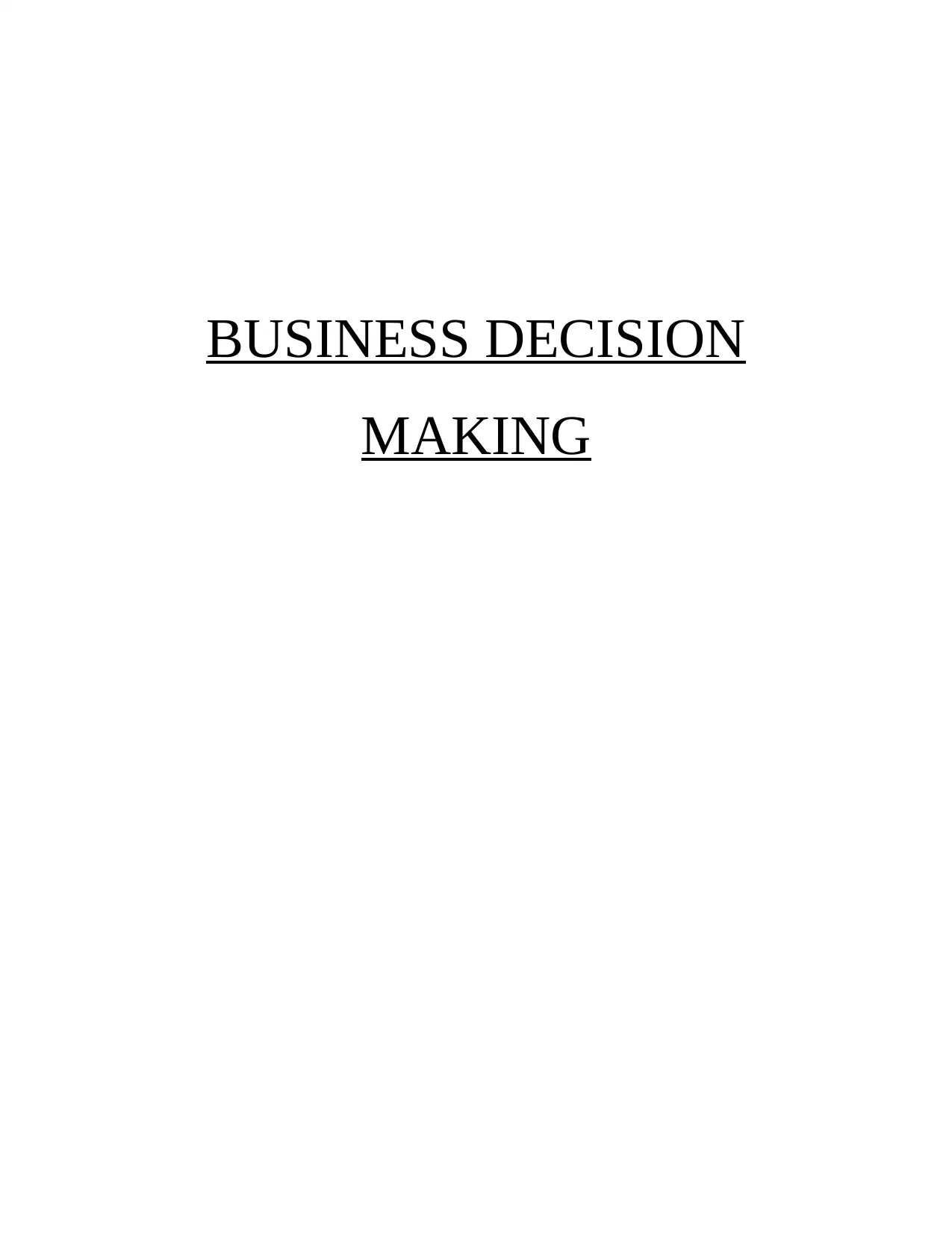
BUSINESS DECISION
MAKING
MAKING
Secure Best Marks with AI Grader
Need help grading? Try our AI Grader for instant feedback on your assignments.
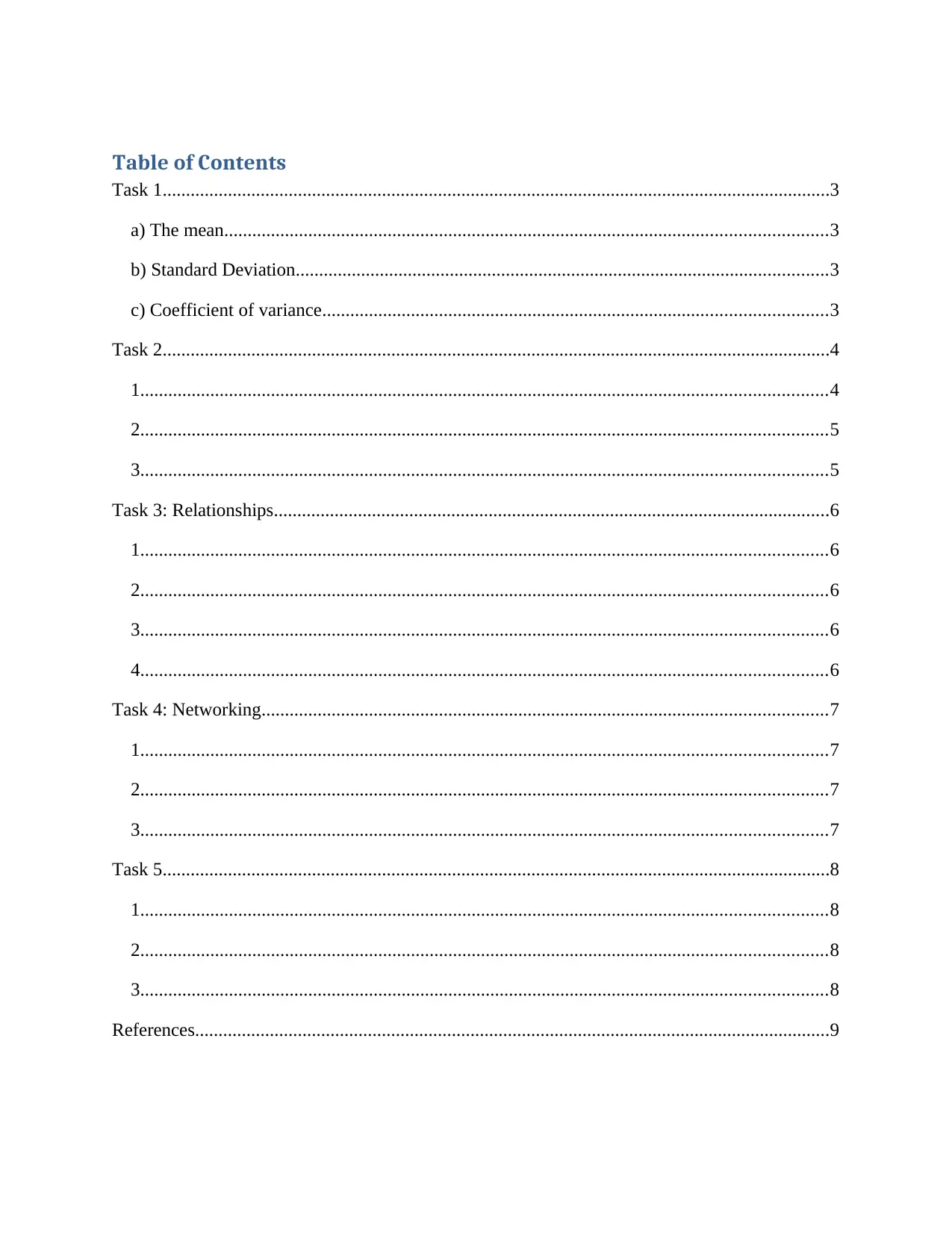
Table of Contents
Task 1...............................................................................................................................................3
a) The mean.................................................................................................................................3
b) Standard Deviation..................................................................................................................3
c) Coefficient of variance............................................................................................................3
Task 2...............................................................................................................................................4
1...................................................................................................................................................4
2...................................................................................................................................................5
3...................................................................................................................................................5
Task 3: Relationships.......................................................................................................................6
1...................................................................................................................................................6
2...................................................................................................................................................6
3...................................................................................................................................................6
4...................................................................................................................................................6
Task 4: Networking.........................................................................................................................7
1...................................................................................................................................................7
2...................................................................................................................................................7
3...................................................................................................................................................7
Task 5...............................................................................................................................................8
1...................................................................................................................................................8
2...................................................................................................................................................8
3...................................................................................................................................................8
References........................................................................................................................................9
Task 1...............................................................................................................................................3
a) The mean.................................................................................................................................3
b) Standard Deviation..................................................................................................................3
c) Coefficient of variance............................................................................................................3
Task 2...............................................................................................................................................4
1...................................................................................................................................................4
2...................................................................................................................................................5
3...................................................................................................................................................5
Task 3: Relationships.......................................................................................................................6
1...................................................................................................................................................6
2...................................................................................................................................................6
3...................................................................................................................................................6
4...................................................................................................................................................6
Task 4: Networking.........................................................................................................................7
1...................................................................................................................................................7
2...................................................................................................................................................7
3...................................................................................................................................................7
Task 5...............................................................................................................................................8
1...................................................................................................................................................8
2...................................................................................................................................................8
3...................................................................................................................................................8
References........................................................................................................................................9
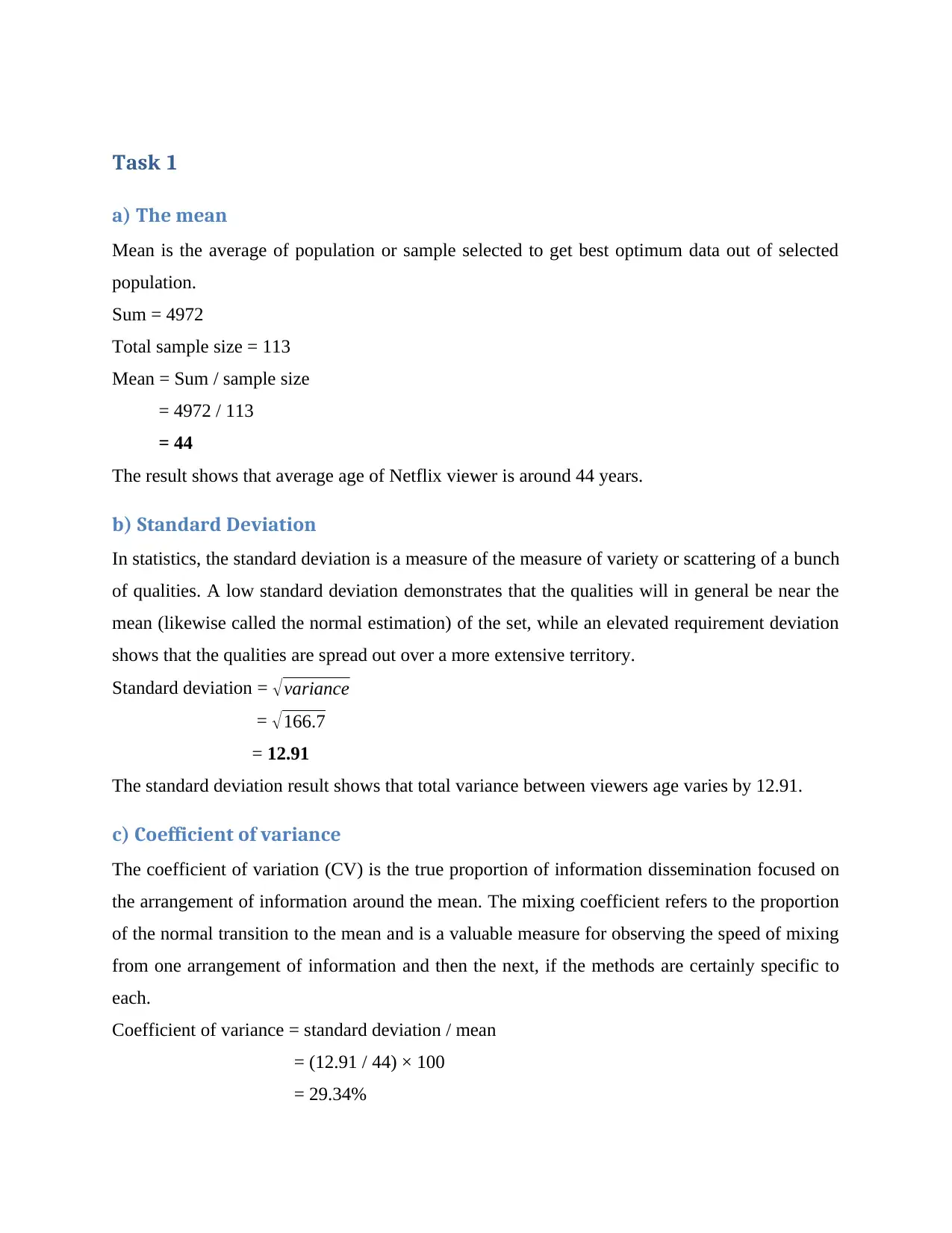
Task 1
a) The mean
Mean is the average of population or sample selected to get best optimum data out of selected
population.
Sum = 4972
Total sample size = 113
Mean = Sum / sample size
= 4972 / 113
= 44
The result shows that average age of Netflix viewer is around 44 years.
b) Standard Deviation
In statistics, the standard deviation is a measure of the measure of variety or scattering of a bunch
of qualities. A low standard deviation demonstrates that the qualities will in general be near the
mean (likewise called the normal estimation) of the set, while an elevated requirement deviation
shows that the qualities are spread out over a more extensive territory.
Standard deviation = √ variance
= √166.7
= 12.91
The standard deviation result shows that total variance between viewers age varies by 12.91.
c) Coefficient of variance
The coefficient of variation (CV) is the true proportion of information dissemination focused on
the arrangement of information around the mean. The mixing coefficient refers to the proportion
of the normal transition to the mean and is a valuable measure for observing the speed of mixing
from one arrangement of information and then the next, if the methods are certainly specific to
each.
Coefficient of variance = standard deviation / mean
= (12.91 / 44) × 100
= 29.34%
a) The mean
Mean is the average of population or sample selected to get best optimum data out of selected
population.
Sum = 4972
Total sample size = 113
Mean = Sum / sample size
= 4972 / 113
= 44
The result shows that average age of Netflix viewer is around 44 years.
b) Standard Deviation
In statistics, the standard deviation is a measure of the measure of variety or scattering of a bunch
of qualities. A low standard deviation demonstrates that the qualities will in general be near the
mean (likewise called the normal estimation) of the set, while an elevated requirement deviation
shows that the qualities are spread out over a more extensive territory.
Standard deviation = √ variance
= √166.7
= 12.91
The standard deviation result shows that total variance between viewers age varies by 12.91.
c) Coefficient of variance
The coefficient of variation (CV) is the true proportion of information dissemination focused on
the arrangement of information around the mean. The mixing coefficient refers to the proportion
of the normal transition to the mean and is a valuable measure for observing the speed of mixing
from one arrangement of information and then the next, if the methods are certainly specific to
each.
Coefficient of variance = standard deviation / mean
= (12.91 / 44) × 100
= 29.34%
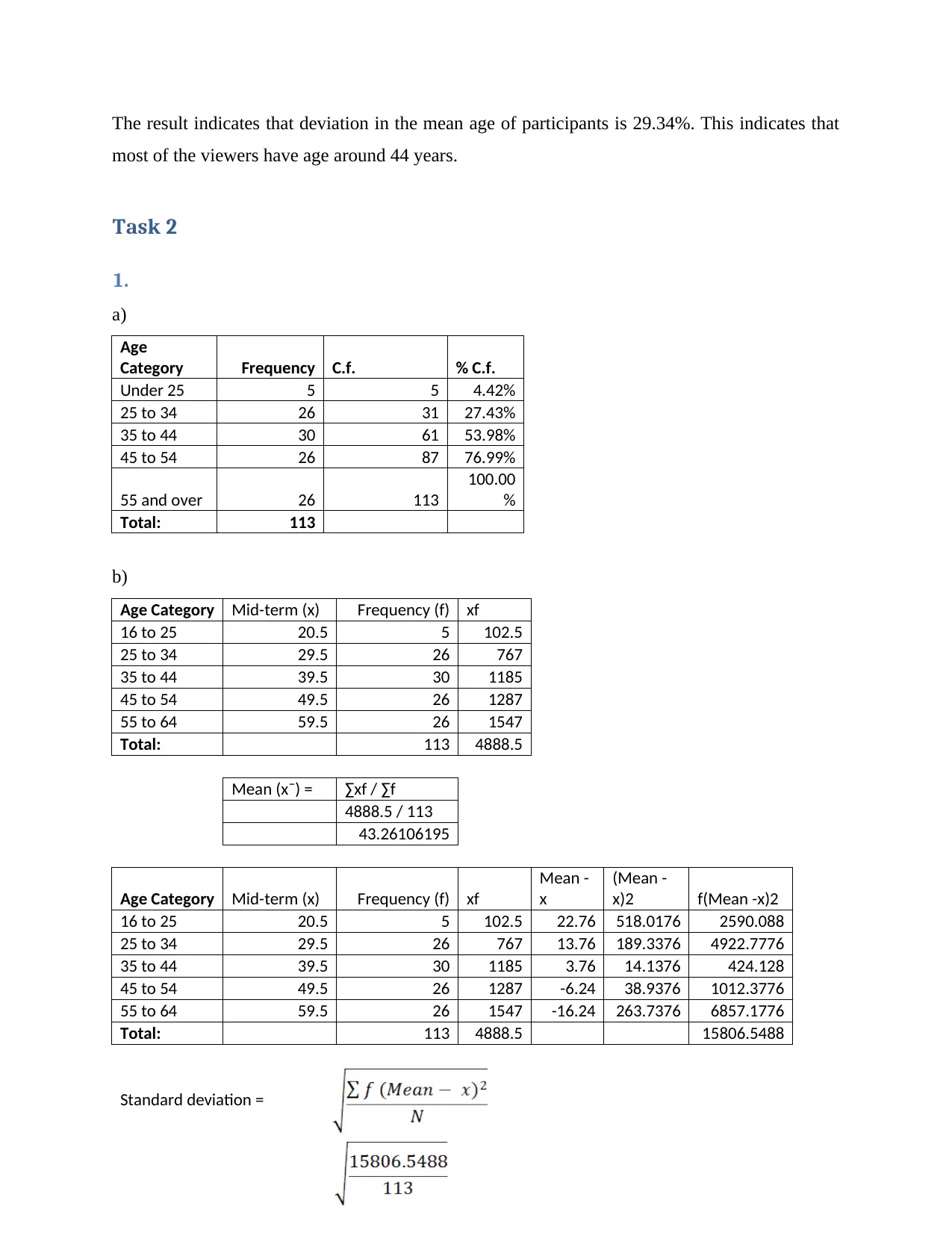
The result indicates that deviation in the mean age of participants is 29.34%. This indicates that
most of the viewers have age around 44 years.
Task 2
1.
a)
Age
Category Frequency C.f. % C.f.
Under 25 5 5 4.42%
25 to 34 26 31 27.43%
35 to 44 30 61 53.98%
45 to 54 26 87 76.99%
55 and over 26 113
100.00
%
Total: 113
b)
Age Category Mid-term (x) Frequency (f) xf
16 to 25 20.5 5 102.5
25 to 34 29.5 26 767
35 to 44 39.5 30 1185
45 to 54 49.5 26 1287
55 to 64 59.5 26 1547
Total: 113 4888.5
Mean (x¯) = ∑xf / ∑f
4888.5 / 113
43.26106195
Age Category Mid-term (x) Frequency (f) xf
Mean -
x
(Mean -
x)2 f(Mean -x)2
16 to 25 20.5 5 102.5 22.76 518.0176 2590.088
25 to 34 29.5 26 767 13.76 189.3376 4922.7776
35 to 44 39.5 30 1185 3.76 14.1376 424.128
45 to 54 49.5 26 1287 -6.24 38.9376 1012.3776
55 to 64 59.5 26 1547 -16.24 263.7376 6857.1776
Total: 113 4888.5 15806.5488
Standard deviation =
most of the viewers have age around 44 years.
Task 2
1.
a)
Age
Category Frequency C.f. % C.f.
Under 25 5 5 4.42%
25 to 34 26 31 27.43%
35 to 44 30 61 53.98%
45 to 54 26 87 76.99%
55 and over 26 113
100.00
%
Total: 113
b)
Age Category Mid-term (x) Frequency (f) xf
16 to 25 20.5 5 102.5
25 to 34 29.5 26 767
35 to 44 39.5 30 1185
45 to 54 49.5 26 1287
55 to 64 59.5 26 1547
Total: 113 4888.5
Mean (x¯) = ∑xf / ∑f
4888.5 / 113
43.26106195
Age Category Mid-term (x) Frequency (f) xf
Mean -
x
(Mean -
x)2 f(Mean -x)2
16 to 25 20.5 5 102.5 22.76 518.0176 2590.088
25 to 34 29.5 26 767 13.76 189.3376 4922.7776
35 to 44 39.5 30 1185 3.76 14.1376 424.128
45 to 54 49.5 26 1287 -6.24 38.9376 1012.3776
55 to 64 59.5 26 1547 -16.24 263.7376 6857.1776
Total: 113 4888.5 15806.5488
Standard deviation =
Secure Best Marks with AI Grader
Need help grading? Try our AI Grader for instant feedback on your assignments.
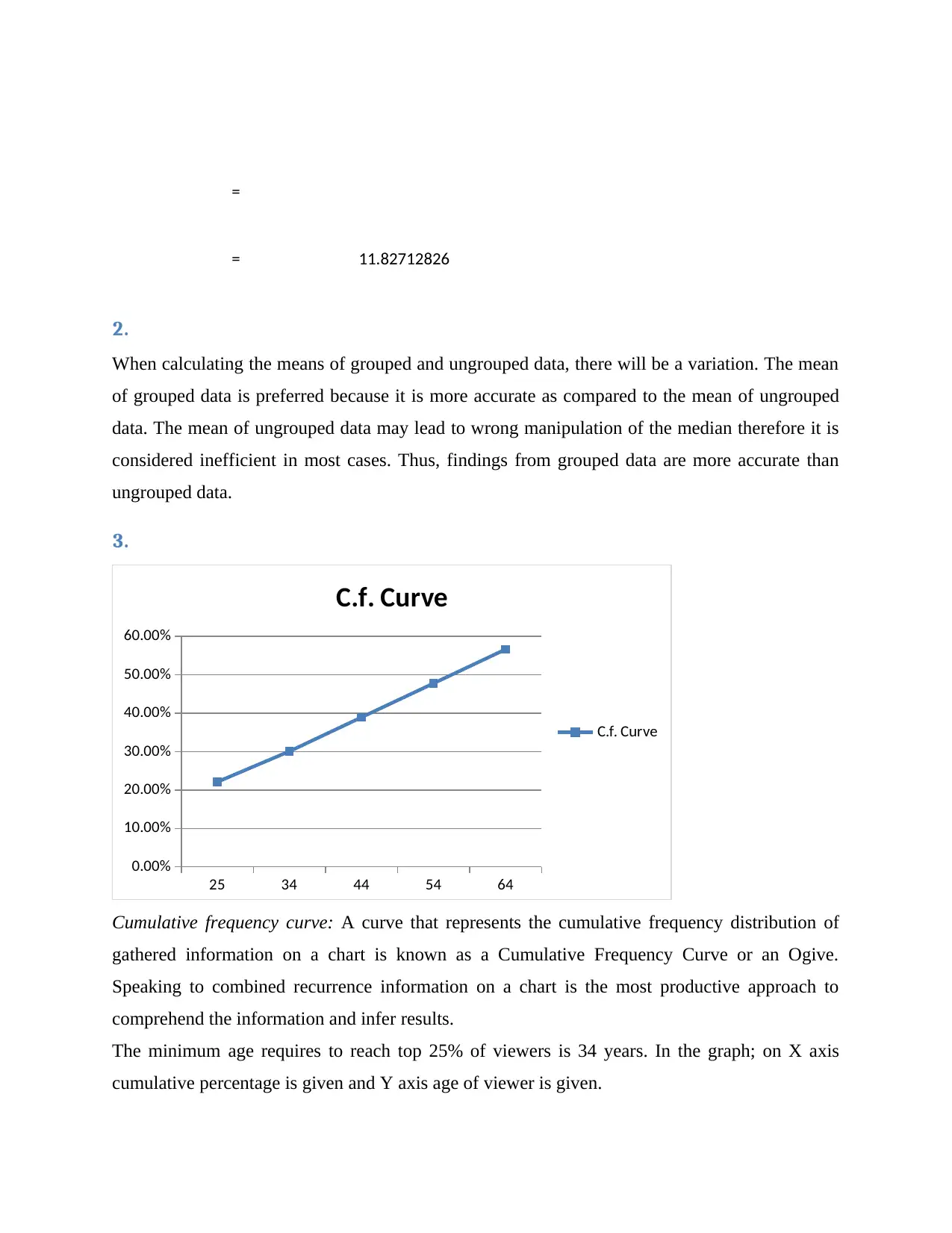
=
= 11.82712826
2.
When calculating the means of grouped and ungrouped data, there will be a variation. The mean
of grouped data is preferred because it is more accurate as compared to the mean of ungrouped
data. The mean of ungrouped data may lead to wrong manipulation of the median therefore it is
considered inefficient in most cases. Thus, findings from grouped data are more accurate than
ungrouped data.
3.
25 34 44 54 64
0.00%
10.00%
20.00%
30.00%
40.00%
50.00%
60.00%
C.f. Curve
C.f. Curve
Cumulative frequency curve: A curve that represents the cumulative frequency distribution of
gathered information on a chart is known as a Cumulative Frequency Curve or an Ogive.
Speaking to combined recurrence information on a chart is the most productive approach to
comprehend the information and infer results.
The minimum age requires to reach top 25% of viewers is 34 years. In the graph; on X axis
cumulative percentage is given and Y axis age of viewer is given.
= 11.82712826
2.
When calculating the means of grouped and ungrouped data, there will be a variation. The mean
of grouped data is preferred because it is more accurate as compared to the mean of ungrouped
data. The mean of ungrouped data may lead to wrong manipulation of the median therefore it is
considered inefficient in most cases. Thus, findings from grouped data are more accurate than
ungrouped data.
3.
25 34 44 54 64
0.00%
10.00%
20.00%
30.00%
40.00%
50.00%
60.00%
C.f. Curve
C.f. Curve
Cumulative frequency curve: A curve that represents the cumulative frequency distribution of
gathered information on a chart is known as a Cumulative Frequency Curve or an Ogive.
Speaking to combined recurrence information on a chart is the most productive approach to
comprehend the information and infer results.
The minimum age requires to reach top 25% of viewers is 34 years. In the graph; on X axis
cumulative percentage is given and Y axis age of viewer is given.
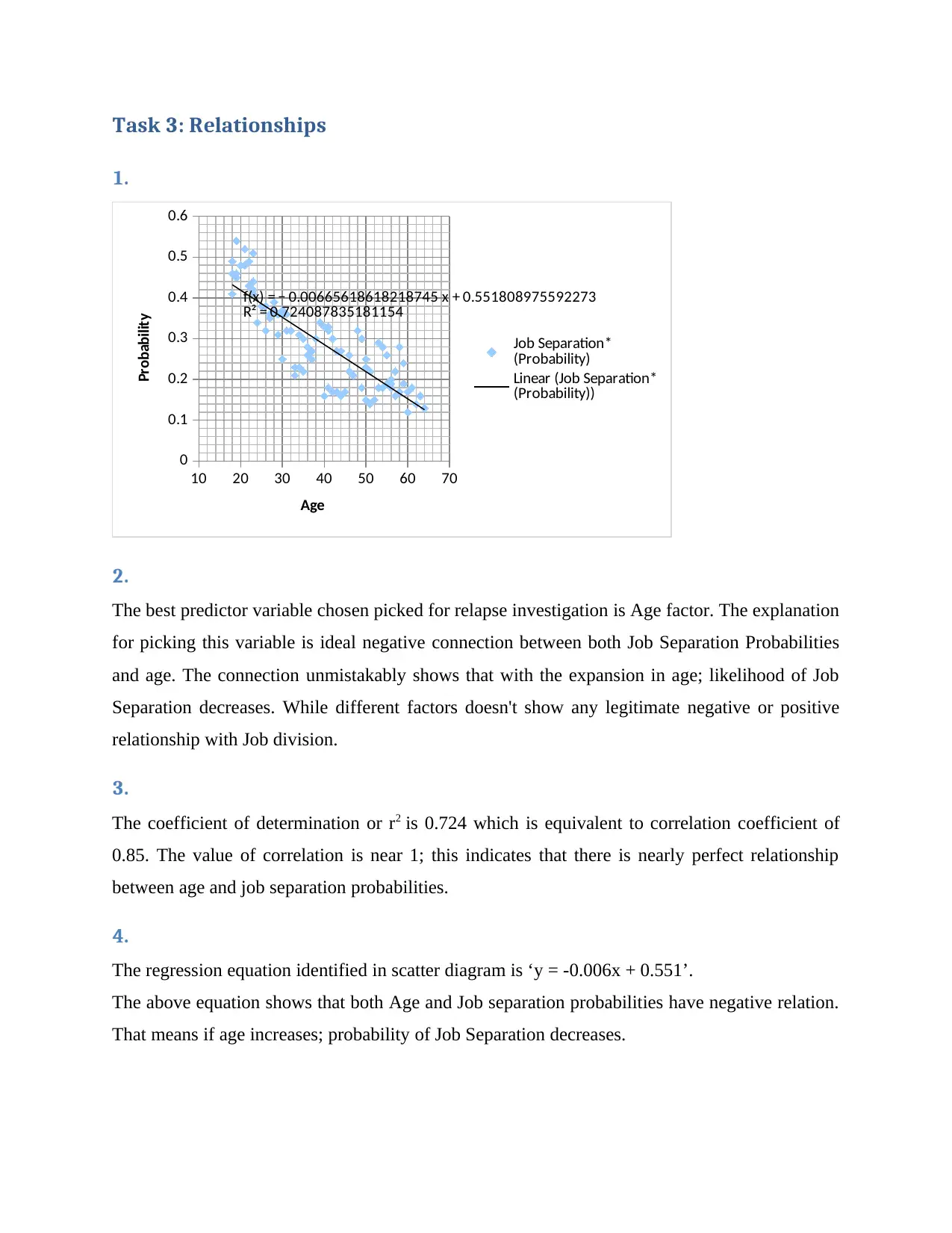
Task 3: Relationships
1.
10 20 30 40 50 60 70
0
0.1
0.2
0.3
0.4
0.5
0.6
f(x) = − 0.00665618618218745 x + 0.551808975592273
R² = 0.724087835181154
Job Separation*
(Probability)
Linear (Job Separation*
(Probability))
Age
Probability
2.
The best predictor variable chosen picked for relapse investigation is Age factor. The explanation
for picking this variable is ideal negative connection between both Job Separation Probabilities
and age. The connection unmistakably shows that with the expansion in age; likelihood of Job
Separation decreases. While different factors doesn't show any legitimate negative or positive
relationship with Job division.
3.
The coefficient of determination or r2 is 0.724 which is equivalent to correlation coefficient of
0.85. The value of correlation is near 1; this indicates that there is nearly perfect relationship
between age and job separation probabilities.
4.
The regression equation identified in scatter diagram is ‘y = -0.006x + 0.551’.
The above equation shows that both Age and Job separation probabilities have negative relation.
That means if age increases; probability of Job Separation decreases.
1.
10 20 30 40 50 60 70
0
0.1
0.2
0.3
0.4
0.5
0.6
f(x) = − 0.00665618618218745 x + 0.551808975592273
R² = 0.724087835181154
Job Separation*
(Probability)
Linear (Job Separation*
(Probability))
Age
Probability
2.
The best predictor variable chosen picked for relapse investigation is Age factor. The explanation
for picking this variable is ideal negative connection between both Job Separation Probabilities
and age. The connection unmistakably shows that with the expansion in age; likelihood of Job
Separation decreases. While different factors doesn't show any legitimate negative or positive
relationship with Job division.
3.
The coefficient of determination or r2 is 0.724 which is equivalent to correlation coefficient of
0.85. The value of correlation is near 1; this indicates that there is nearly perfect relationship
between age and job separation probabilities.
4.
The regression equation identified in scatter diagram is ‘y = -0.006x + 0.551’.
The above equation shows that both Age and Job separation probabilities have negative relation.
That means if age increases; probability of Job Separation decreases.
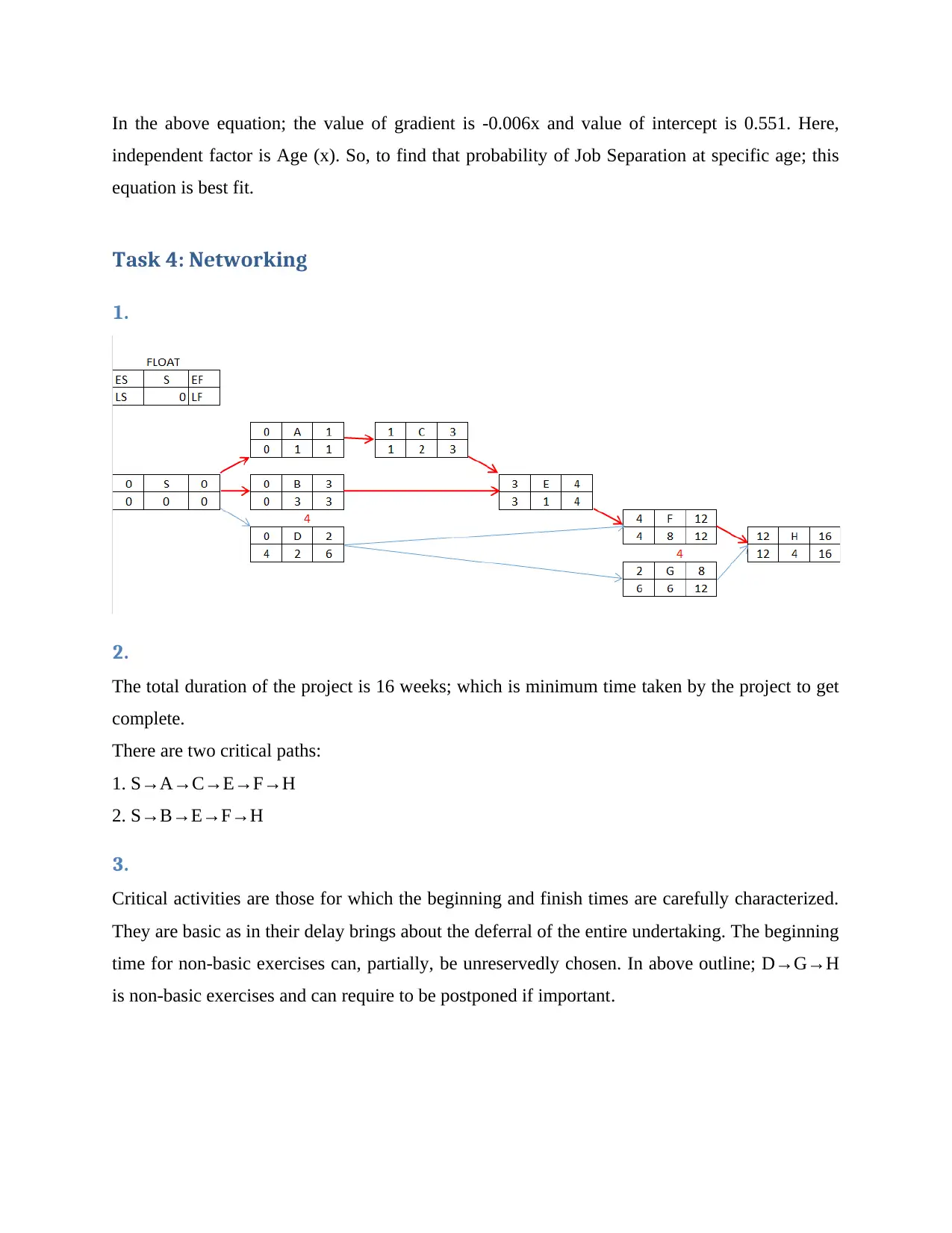
In the above equation; the value of gradient is -0.006x and value of intercept is 0.551. Here,
independent factor is Age (x). So, to find that probability of Job Separation at specific age; this
equation is best fit.
Task 4: Networking
1.
2.
The total duration of the project is 16 weeks; which is minimum time taken by the project to get
complete.
There are two critical paths:
1. S→A→C→E→F→H
2. S→B→E→F→H
3.
Critical activities are those for which the beginning and finish times are carefully characterized.
They are basic as in their delay brings about the deferral of the entire undertaking. The beginning
time for non-basic exercises can, partially, be unreservedly chosen. In above outline; D→G→H
is non-basic exercises and can require to be postponed if important.
independent factor is Age (x). So, to find that probability of Job Separation at specific age; this
equation is best fit.
Task 4: Networking
1.
2.
The total duration of the project is 16 weeks; which is minimum time taken by the project to get
complete.
There are two critical paths:
1. S→A→C→E→F→H
2. S→B→E→F→H
3.
Critical activities are those for which the beginning and finish times are carefully characterized.
They are basic as in their delay brings about the deferral of the entire undertaking. The beginning
time for non-basic exercises can, partially, be unreservedly chosen. In above outline; D→G→H
is non-basic exercises and can require to be postponed if important.
Paraphrase This Document
Need a fresh take? Get an instant paraphrase of this document with our AI Paraphraser
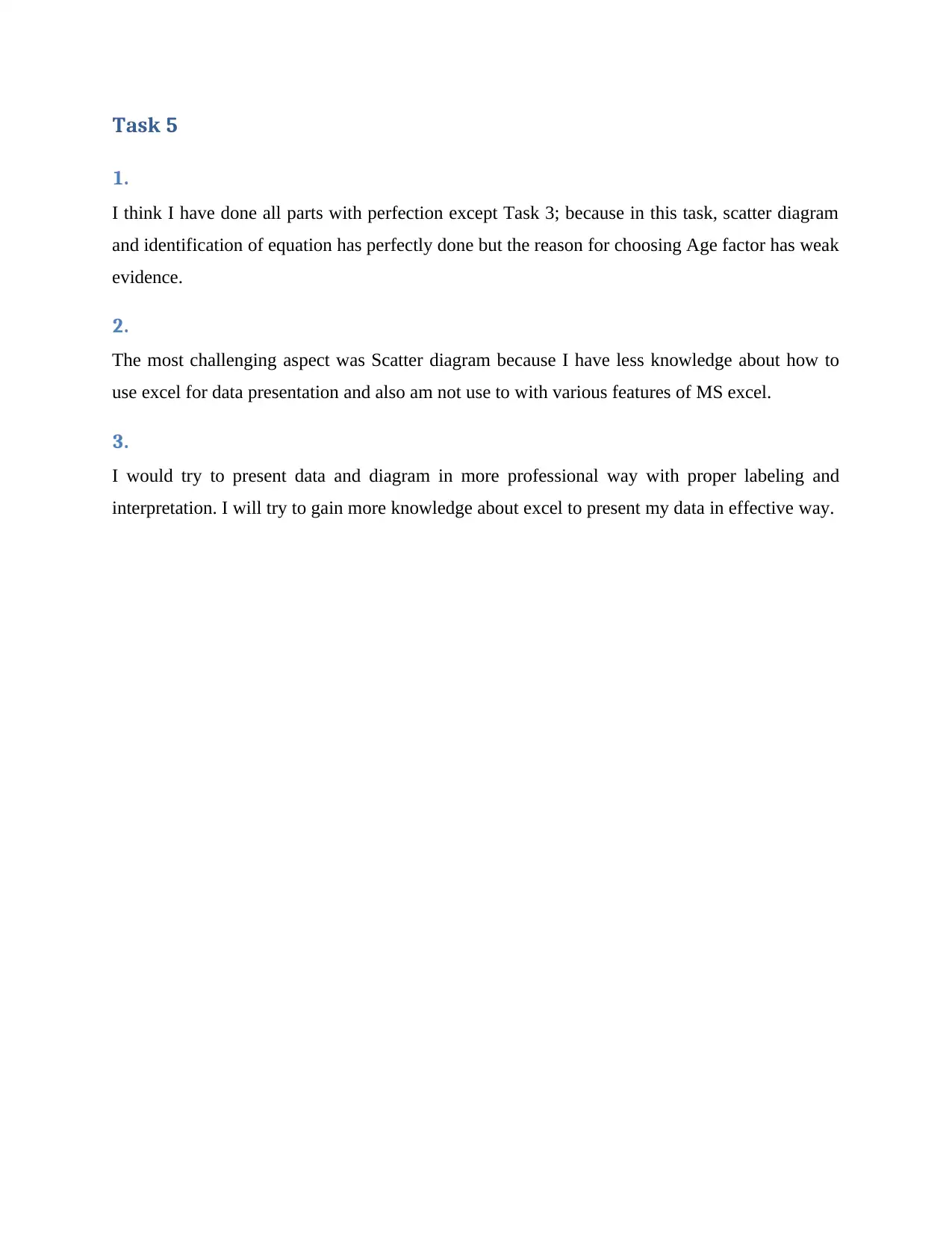
Task 5
1.
I think I have done all parts with perfection except Task 3; because in this task, scatter diagram
and identification of equation has perfectly done but the reason for choosing Age factor has weak
evidence.
2.
The most challenging aspect was Scatter diagram because I have less knowledge about how to
use excel for data presentation and also am not use to with various features of MS excel.
3.
I would try to present data and diagram in more professional way with proper labeling and
interpretation. I will try to gain more knowledge about excel to present my data in effective way.
1.
I think I have done all parts with perfection except Task 3; because in this task, scatter diagram
and identification of equation has perfectly done but the reason for choosing Age factor has weak
evidence.
2.
The most challenging aspect was Scatter diagram because I have less knowledge about how to
use excel for data presentation and also am not use to with various features of MS excel.
3.
I would try to present data and diagram in more professional way with proper labeling and
interpretation. I will try to gain more knowledge about excel to present my data in effective way.
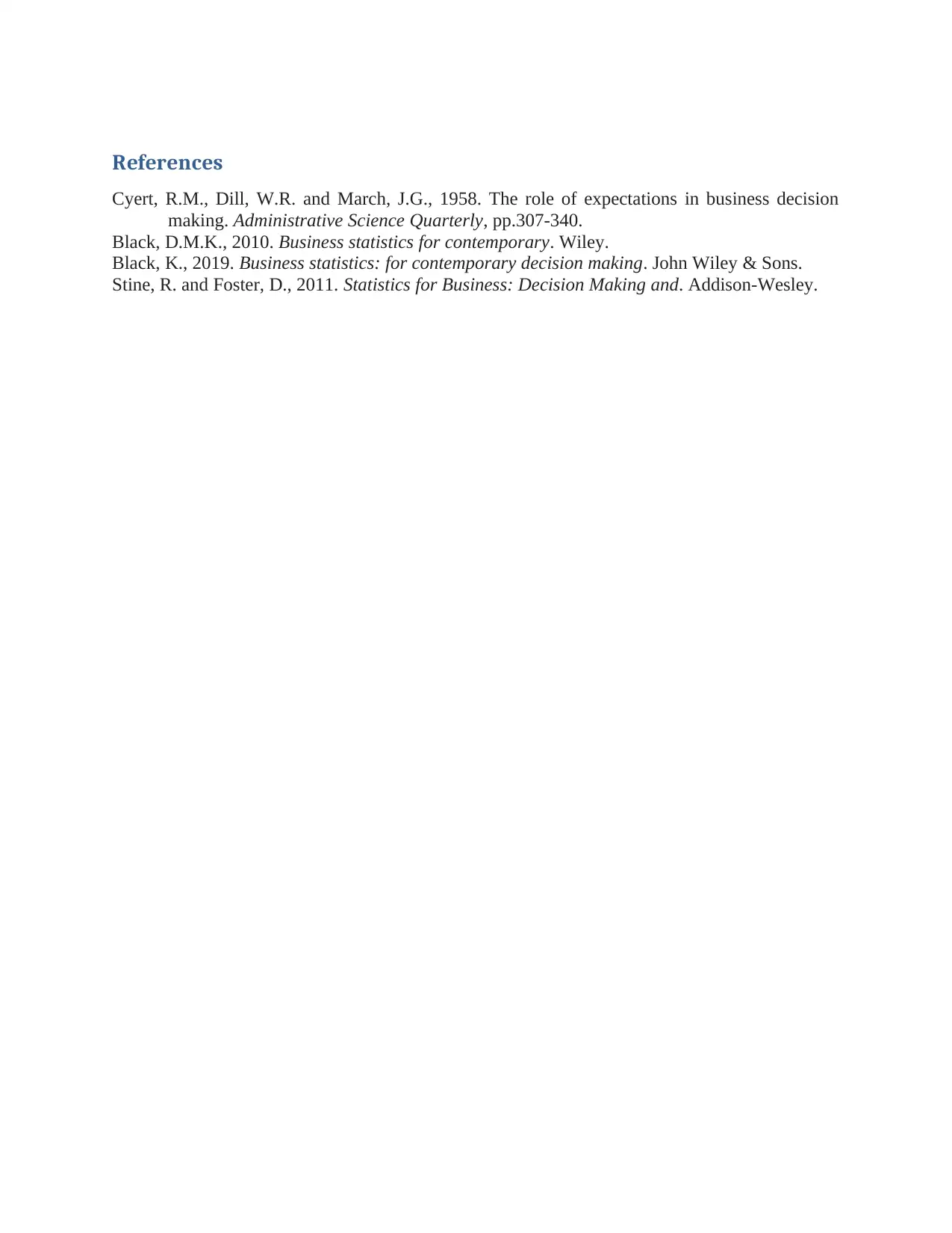
References
Cyert, R.M., Dill, W.R. and March, J.G., 1958. The role of expectations in business decision
making. Administrative Science Quarterly, pp.307-340.
Black, D.M.K., 2010. Business statistics for contemporary. Wiley.
Black, K., 2019. Business statistics: for contemporary decision making. John Wiley & Sons.
Stine, R. and Foster, D., 2011. Statistics for Business: Decision Making and. Addison-Wesley.
Cyert, R.M., Dill, W.R. and March, J.G., 1958. The role of expectations in business decision
making. Administrative Science Quarterly, pp.307-340.
Black, D.M.K., 2010. Business statistics for contemporary. Wiley.
Black, K., 2019. Business statistics: for contemporary decision making. John Wiley & Sons.
Stine, R. and Foster, D., 2011. Statistics for Business: Decision Making and. Addison-Wesley.
1 out of 9
Related Documents
Your All-in-One AI-Powered Toolkit for Academic Success.
+13062052269
info@desklib.com
Available 24*7 on WhatsApp / Email
![[object Object]](/_next/static/media/star-bottom.7253800d.svg)
Unlock your academic potential
© 2024 | Zucol Services PVT LTD | All rights reserved.





